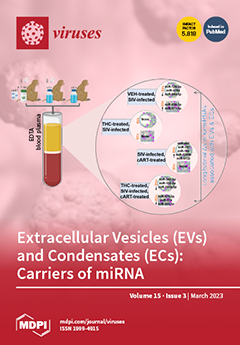Mayaro virus (MAYV) is transmitted by
Haemagogus spp. mosquitoes and has been circulating in Amazon areas in the North and Central West regions of Brazil since the 1980s, with an increase in human case notifications in the last 10 years. MAYV introduction in urban areas is a public health concern as infections can cause severe symptoms similar to other alphaviruses. Studies with
Aedes aegypti have demonstrated the potential vector competence of the species and the detection of MAYV in urban populations of mosquitoes. Considering the two most abundant urban mosquito species in Brazil, we investigated the dynamics of MAYV transmission by
Ae. aegypti and
Culex quinquefasciatus in a mice model. Mosquito colonies were artificially fed with blood containing MAYV and infection (IR) and dissemination rates (DR) were evaluated. On the 7th day post-infection (dpi), IFNAR BL/6 mice were made available as a blood source to both mosquito species. After the appearance of clinical signs of infection, a second blood feeding was performed with a new group of non-infected mosquitoes. RT-qPCR and plaque assays were carried out with animal and mosquito tissues to determine IR and DR. For
Ae. aegypti, we found an IR of 97.5–100% and a DR reached 100% in both 7 and 14 dpi. While IR and DR for
Cx. quinquefasciatus was 13.1–14.81% and 60% to 80%, respectively. A total of 18 mice were used (test = 12 and control = 6) for
Ae. aegypti and 12 (test = 8 and control = 4) for
Cx. quinquefasciatus to evaluate the mosquito–mice transmission rate. All mice that were bitten by infected
Ae. aegypti showed clinical signs of infection while all mice exposed to infected
Cx. quinquefasciatus mosquitoes remained healthy. Viremia in the mice from
Ae. aegypti group ranged from 2.5 × 10
8 to 5 × 10
9 PFU/mL.
Ae. aegypti from the second blood feeding showed a 50% IR. Our study showed the applicability of an efficient model to complete arbovirus transmission cycle studies and suggests that the
Ae. aegypti population evaluated is a competent vector for MAYV, while highlighting the vectorial capacity of
Ae. aegypti and the possible introduction into urban areas. The mice model employed here is an important tool for arthropod–vector transmission studies with laboratory and field mosquito populations, as well as with other arboviruses.
Full article






